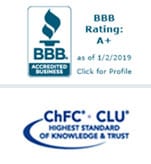
What is a Stretch IRA?
A Stretch IRA is an inherited IRA account where the beneficiary has chosen to “stretch” taxable distributions over the course of their own life expectancy.
When an IRA is inherited by someone other than the original owner’s spouse (called a “non-spousal beneficiary”), this person can either take advantage of the stretch option and take required minimum distributions (RMDs) over their lifespan, or they can withdraw (and pay taxes on) the entire account balance within five years of the original owner’s death. Most beneficiaries choose to stretch their IRAs. Here’s why.
With the stretch option:
- |||Beneficiaries make smaller yearly withdrawals, leaving more money in the account to grow.
- |||Beneficiaries reduce their tax burden compared to a lump-sum or five-year distribution schedule since smaller withdrawals = fewer taxes.
- |||Money can remain in the account for more than five years after the death of the original owner.
- |||More money in account + more time in account = greater growth.
Who Should Consider a Stretch IRA?
For account owners: the Stretch IRA option is only available to non-spousal beneficiaries. This is because inheriting spouses have the option to rollover the inherited IRA into their own account or open a new one. In either case, the money does not have to be distributed until they turn 70 ½.
If you know that your spouse will have enough income after you’re gone, leaving your IRA to your children, grandchildren, or even great grandchildren will allow you to build a legacy for generations to come. The stretch option uses the IRS’s single life expectancy table to calculate how much a beneficiary should withdraw, based on their age and the account’s balance as of December 31st. The younger your beneficiary, the longer the account will have to grow.
Make sure that your current IRA custodian allows beneficiaries to use the stretch option. You will also need to make sure that your beneficiaries know what the stretch is and how to use it.
For beneficiaries: if you do not need the entire account balance immediately to pay off debt or another relevant expense, we strongly recommend taking advantage of the Stretch IRA. After all, depending on your income and the size of the account, up to 40% of the IRA balance could be lost to taxes if you opt for a lump-sum distribution. However, certain steps must be taken in order to enact a stretch.
How Can I Stretch My IRA?
Stretch IRAs require careful planning on the part of the original account owner and the beneficiary. Here are the steps you’ll need to follow.
- |||Beneficiaries should be informed that the stretch is part of your estate plan.This can be done by your estate planner or a trusted financial advisor. Beneficiaries will also need explicit instruction in how to execute the stretch. This is better left to a professional.
- |||The beneficiary must rename the account so it includes their name and the name of the original account owner, where each name is clearly identifiable, e.g. “John Deer (deceased September 16, 2019) for the benefit of Jane Doe.”
- |||Starting in the year following the original account owner’s death, the beneficiary must take required minimum distributions every year before December 31st. There is no early-withdrawal penalty for beneficiaries under age 59; however, these distributions will be taxed as income unless the funds came from a Roth IRA. Missed or late distributions are subject to a brutal 50% penalty from the IRS.
- |||If multiple beneficiaries inherit the account, the account should be split by December 31st of the year after the account owner’s death. If this doesn’t occur, RMDs will be calculated based on the life expectancy of the oldest heir. This could be an issue, especially if the oldest beneficiary is 55 and the youngest just graduated high school.


Sara McKinney
saractag@gmail.com
As Cowen Tax Advisory Group’s Digital Content Marketing Specialist, Sara provides in-house copywriting and manages the company’s electronic records system, email marketing, and blog.




